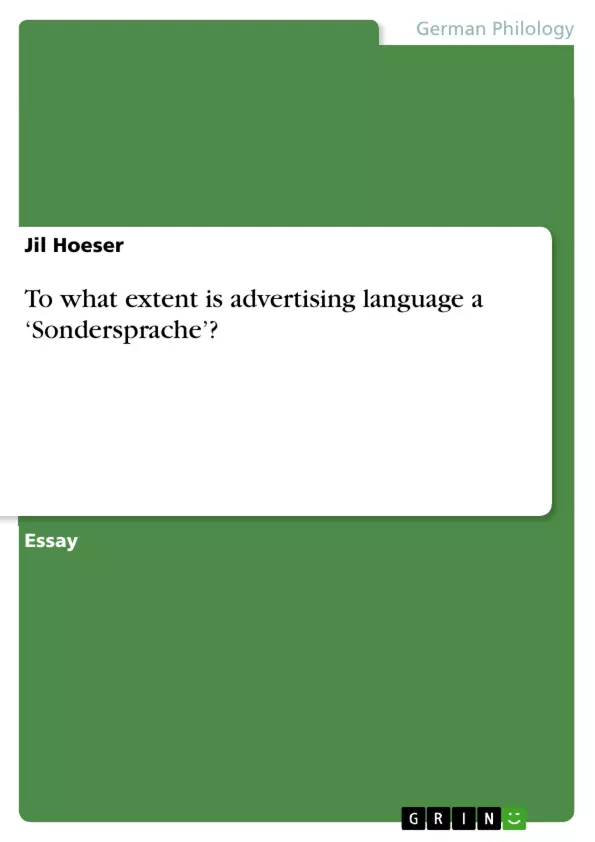Advertising happens in a lot of areas of life, such as politics or charity, and it almost every time happens by means of a specific use of language. Exactly this specific use of the language in advertising will be the main focus of the following essay and we are going to ask if advertising language can be seen as a ‘Sondersprache’. After providing a general definition of advertising and analysing its different techniques to influence peoples’ behaviour, we will deal with the linguistic characteristics. Finally, after exposing the linguistic features of advertising, we shall analyse, whether advertising language could be seen as a ‘Sondersprache’.
Nowadays, we encounter advertising like “Saturn: Geiz ist geil!” in the most different forms in our everyday life. Whether it is on flyers, on the radio or on the television, everywhere we look, advertising is flooding us.
We hear a specific melody coming from the radio and we know what product is meant; we see a little green crocodile in the left corner of a t-shirt and we directly know what brand it is from. At this stage, these two examples show us to what extent advertising is surrounding us. What is more, we can already observe a first tendency: advertising is not only using language, but it is also playing our minds with pictures and music. Most people link this term only to commercial and product advertising, but that definition is far too tight.
Inhaltsverzeichnis (Table of Contents)
- Defining Advertising
- Linguistic characterisations of advertising.
- Lexis
- Word classes and word formation
- Foreign-language elements.
- High-quality words and keywords.......
- Phraseology
- Syntax.
- Grammar
- Rhetoric
- Varieties
- Advertising as a 'Sondersprache'.
- Conclusion.
Zielsetzung und Themenschwerpunkte (Objectives and Key Themes)
This essay examines the nature of advertising language, focusing on whether it qualifies as a 'Sondersprache' (special language). The essay begins by defining advertising and analyzing its techniques to influence behavior. It then delves into the linguistic characteristics of advertising, exploring its use of lexis, phraseology, syntax, grammar, rhetoric, and varieties. Finally, the essay analyzes whether these linguistic features support classifying advertising language as a 'Sondersprache'.
- Defining advertising and its various types
- Analyzing the techniques used in advertising to influence behavior
- Exploring the linguistic characteristics of advertising language
- Examining the use of lexis, phraseology, syntax, grammar, rhetoric, and varieties in advertising
- Determining whether advertising language can be classified as a 'Sondersprache'
Zusammenfassung der Kapitel (Chapter Summaries)
- Defining Advertising: This chapter provides a comprehensive definition of advertising, differentiating between commercial and non-commercial types, and exploring different forms such as prestige advertising, industrial advertising, and consumer advertising. It further examines the distinction between public and private communication, highlighting the unique characteristics of advertising in public contexts. The chapter also discusses the role of advertising in media, particularly television, and its impact on language usage.
- Linguistic characterisations of advertising: This chapter focuses on the linguistic features of advertising. It begins by defining denotation, connotation, and association, providing a framework for understanding the meaning of words in advertising. The chapter then analyzes word classes and word formation, highlighting the preference for substantives, adjectives, and verbs. It also examines the use of neologisms, foreign-language elements, and abbreviations in advertising.
Schlüsselwörter (Keywords)
The main keywords and focus topics of this essay are: advertising language, 'Sondersprache', linguistic characteristics, lexis, phraseology, syntax, grammar, rhetoric, varieties, denotation, connotation, association, word classes, word formation, neologisms, foreign-language elements, abbreviations, persuasion, influence.
- Quote paper
- Jil Hoeser (Author), 2016, To what extent is advertising language a ‘Sondersprache’?, Munich, GRIN Verlag, https://www.grin.com/document/316415



